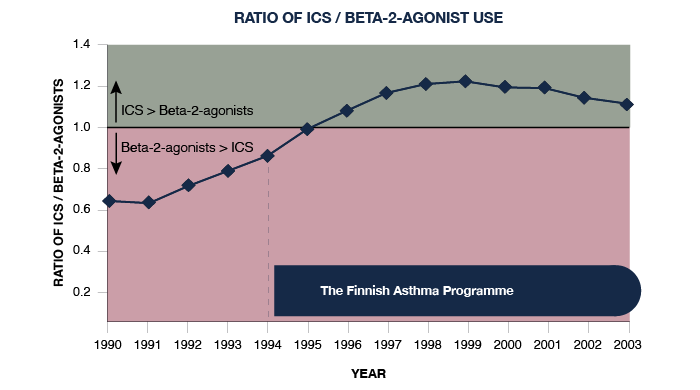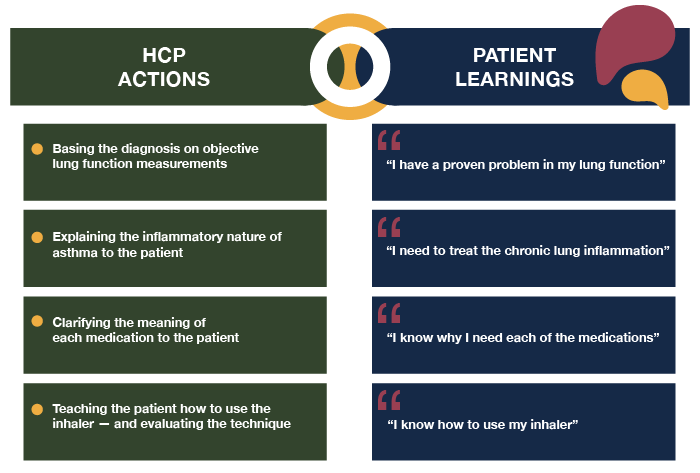EPISODE 4
The Finnish approach
to asthma treatment
Introduction
Finland is widely acknowledged as one of the leading countries in terms of providing high-quality care for asthma. How was this achieved, and what steps can healthcare professionals take to enhance the well-being of patients with asthma? Chief Physician Jussi Karjalainen and Professor Lauri Lehtimäki discuss these topics in a video interview. Discover additional insights to enhance asthma care, including strategies for improving patient adherence, in the text below.
The Finnish approach to asthma treatment
The Finnish Asthma Programme (1994–2004) aimed to improve the standards of asthma management, with a particular focus on unifying treatment practices at the national level. (1) National Current Care Guidelines for asthma were introduced for the first time during the programme, accompanied by extensive training of healthcare professionals in these updated practices. (2) The mutual training also supported the establishment of a network of healthcare professionals specialised in asthma care. This network facilitated effective communication and streamlined the dissemination of new developments to clinical practice.
Consistent messages to improve treatment adherence
Professor Lauri Lehtimäki and Chief Physician Jussi Karjalainen both agreed that the Finnish asthma treatment practices largely align with international guidelines. However, the key differentiating factor lies in the execution: ensuring consistent and thorough implementation of the guidelines across the national healthcare system.
Asthma diagnoses are always based on objective lung function measurements, and the treatment is practically always started with inhaled corticosteroids (ICS) containing controller medication. Objective and quantifiable measurements can effectively demonstrate to patients the importance of consistent controller treatment beyond symptom control. When the message is repeated by general practitioners, nurses, and pharmacists, and even patient organisations, its impact is strengthened and reinforced.
Choosing a suitable inhaler and assuring the correct use
The Finnish Current Care Guidelines offer guidance on choosing a suitable inhaler device for each patient. The dry powder inhalers (DPIs) or soft mist inhalers (SMIs) are recommended instead of pressurised metered dose inhalers (pMDIs), if there are no clinical reasons to choose otherwise. This is due to the environmental aspects: DPIs and SMIs have a smaller carbon footprint compared to pMDIs. (2)
The Finnish guidelines also emphasise the importance of monitoring asthma control. If the treatment response is inadequate or asthma remains uncontrolled, it is essential to verify the correct diagnosis, assess inhaler usage and adherence, and consider comorbidities and additional risk factors. (2)
Achievements and learnings of the Finnish Asthma Programme
The consistent initiation of ICS treatment, for practically all patients with asthma rather than relying only on beta-2-agonists, proved impactful during the Finnish Asthma Programme: it led to a 75% increase in the number of patients using ICS from 1994 to 1999 (Figure 1). At the end of the programme, over 85% of patients purchasing asthma medications from pharmacies used ICS daily. (1)

Figure 1. Ratio of consumption of inhaled corticosteroids (ICS) and beta-2-agonists from 1990 to 2003, in defined daily doses (ddd/1000 inhabitants/day). A combination treatment of corticosteroid and beta-2-agonist is included in both drug classes. A ratio below one (red background) indicates a higher usage of beta-2-agonists compared to ICS, whereas a ratio over one (green background) signifies a higher usage of ICS compared to beta-2-agonists. (1)
One of the goals of the Finnish Asthma Programme was to reduce the proportion of patients with severe or moderate asthma from 40% to 20%. During the programme and beyond, the proportion of patients with severe asthma has steadily declined. In the beginning of the programme, approximately 20% of patients had severe asthma. In 2001, 10% of patients reported severe symptoms, and the number declined to 3.8% in 2010 and down to 2.5% in 2016. (3)
The Finnish experience has demonstrated that consistency plays a crucial role in achieving successful asthma care. Clear and consistent messaging from healthcare professionals to patients regarding their treatment enhances treatment adherence (summarised in Figure 2). Efficient networking between healthcare levels aids in keeping the messages consistent. Education and re-education in the treatment practices is also vital — for both health care professionals and patients.

Figure 2. Insights of the Finnish way of employing asthma treatment. The messages from healthcare professionals (HCPs) are given in a consistent manner by physicians, nurses, and pharmacists. Figure is based on the interview of Professor Lehtimäki and Chief Physician Jussi Karjalainen.
You might be interested in these:
References
2. Asthma. Current Care Guidelines. Working group set up by the Finnish Medical Society Duodecim, the Finnish Respiratory Society, Finnish Paediatric Society, and Finnish Society of Clinical Physiology. [Internet]. Helsinki: Finnish Medical Society Duodecim; 2022 [cited 2023 Apr 19]. Available from: www.kaypahoito.fi
RESP-1483d 05/2023